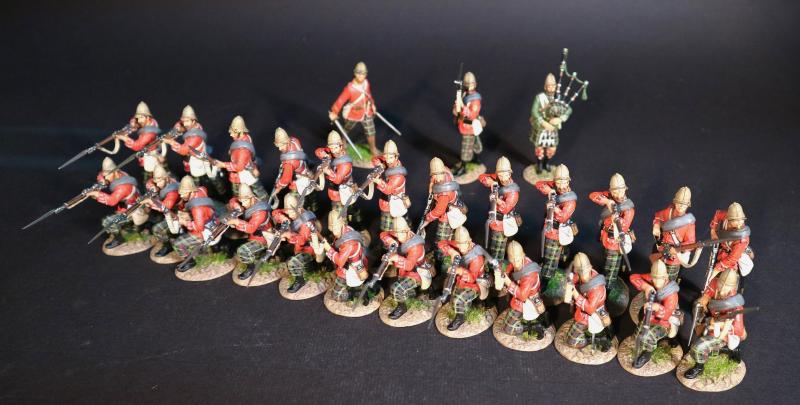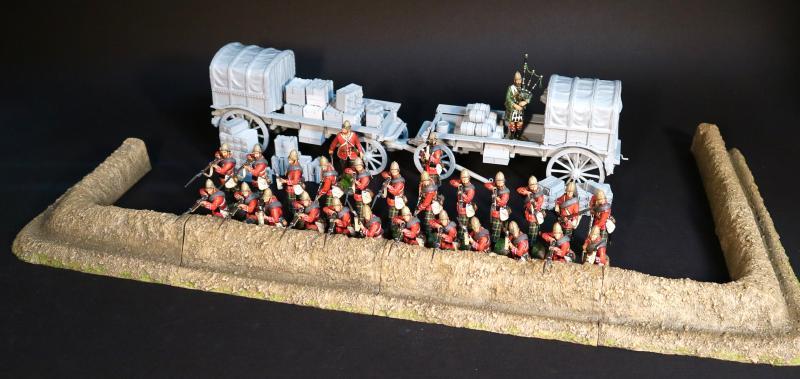Four British Infantry Highlanders, 91st Regiment (Argyllshire Highlanders), Eschowe Relief Column, Battle of Gingindhlovu--four figures
$180.00
Item Number: GG91-05N
Four British Infantry Highlanders, 91st Regiment (Argyllshire Highlanders), Eschowe Relief Column, Battle of Gingindhlovu--four figures
The Battle of Gingindhlovu was fought on 2nd April 1879 between a British relief column sent to break the siege at Eshowe, and a Zulu impi of king Cetshwayo.
The British soldier would refer to it as the Battle of “GIN GIN I LOVE YOU”.
Charles Pearson had led No.1 column of the British invasion force across the Tugela River to establish an advanced base at Eshowe. Having set up a base at a deserted Norwegian mission station, the British found themselves besieged.
A relief column was organized by Lord Chelmsford and departed Fort Tenedos on 29th March to relieve the garrison.
Chelmsford’s relief force comprised 3,390 Europeans, and 2,280 Africans.
ord Chelmsford ensured his men spent much time laagering and entrenching their camp at the end of each day, and kept ammunition boxes open and at the ready.
Although this was slow progress, Pearson’s observers at Eshowe were able to see the relief column entrenched on the south bank of the Neyzane, on the evening of the 1st April.
The Zulu impi was composed of 12,000 warriors, some of whom were Isandlwana veterans drawn from regiments in the main Zulu army, while the remainder were warriors who lived in the vicinity of Eshowe.
Many of the Zulu commanders wanted to attack the relief column that night, but Prince Dabulamanzi KaMpande, who was half brother to king Cetshwayo and commander of the impi’s right wing, convinced them to wait until morning.
At dawn on 2 April 1879, the morning sun revealed muddy ground and a heavy mist. Chelmsford had decided after hearing Dunn's report to not continue on toward Eshowe early the next morning. Instead, he would deploy units of the Natal Native Contingent to feel for the Zulus. As the NNC were preparing to advance shots were heard from the night pickets still on duty. The impi was advancing; the main force split into two columns before crossing the Ineyzane and assuming the "chest and horns" formation. The left horn sharply curved to the right to assault the laager's north-east corner, while the "chest" gently curved toward the north face of the laager.
Another force passed Misi Hill and approached the laager, forming the impi’s right horn.
The buffalo formation came in at a run on the three sides of the laager as Chelmsford had wanted; at a range of 300–400 yd (270–370 m) the British infantry opened fire, supported by the Gatling guns and rockets. Zulu marksmen caused a few casualties within the laager, but the defenders kept the Zulus at bay.
Although the Zulu regiments made persistent rushes to get within stabbing range, their charges lacked the drive and spirit that had pushed them forward at Isandlwana and Rorke’s Drift.
The only zulu to reach the laager was a ten year old boy, who was immediately taken prisoner by members of the naval brigade and later served as a kind of mascot on their ship, Boadicea.
Around 7am, the main impi attack had been halted. Chelmsford ordered his mounted troops to attack, followed by the NNC. Many zulu were killed as they withdrew.
Chelmsford had begun to avenge the Imperial dead of Isandlwana, but for the present he was content to relieve Pearson and return to Natal.
The 91st Highlanders were stationed at Aldershot when they received an order, on 12th February 1879 to proceed on active service to Natal. The regiment formed the advance guard on the Eshowe relief column. During the Battle of Gingindlovu the 91st held the (Southern) rear face of the lager and bore the brunt of the second attack.
After the relief of Eschowe the regiment was employed on convoy duty until it was attached to the 2nd Brigade of Crealock’s 1st Division for the second invasion of Zululand.
Released in SEPTEMBER 2024.


